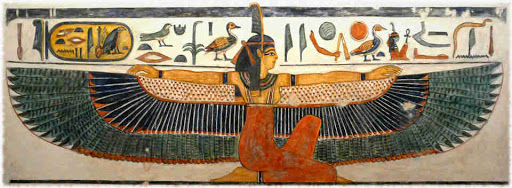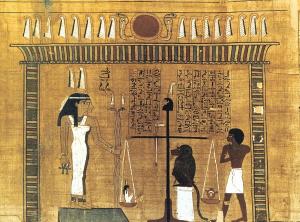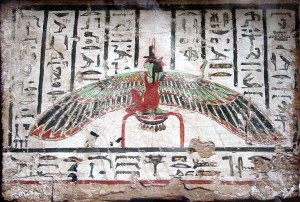I’ve written a lot on this blog about the heliacal (“before the sun”) rising of the Star of Isis—Sirius in Latin, Sothis in Greek, Sopdet in ancient Egyptian—which marked the beginning of the Egyptian New Year and the return of the life-giving Inundation flood. (You’ll find the basic information on Isis and Her holy star here. For more, just search “Sirius” on this blog.)
When Sirius rises in your area depends on your latitude. For me, in 2024, Her rising is August 22, in the hour before dawn. Thanks to the wonders of modern online astronomical calculators, we can know pretty precisely when the Fair Star of the Waters will rise before the sun. (To use the linked calculator and find out when Sirius rises in your area, just enter your email and the password: softtests. You will need to know the latitude and altitude of wherever you are observing Her rise. This info is easily google-able.)
But for the ancient Egyptians, and for those of us who honor the Ancient Egyptian Deities today, something else happens prior to the rising of Our Lady’s star: the “Five Days Upon the Year” or the epagomenal days. These were five days outside of time that marked the transition from the Old Year to the New Year. These five days, added to the Egyptian 360-day year, brought them up to the requisite 365 (or almost; they were short a quarter-day).

On these five days, the birthdays of Osiris, Horus (or Horus the Elder), Set, Isis, and Nephthys were celebrated. But this time wasn’t just a happy birthday party for the Deities. This time-outside-of-time, this liminal period, was also a period of great danger. This was the period before the coming of the yearly flood that fertilized Egypt’s fields along the Nile. It was the time of the lowest water; in some places, boats could no longer navigate. All along the Nile banks, everything was drying out. The food stores from last year’s harvests were running low. People were beginning to anticipate—and be anxious about—how high the waters would rise this year. Would there be famine or feast?
To those of us in the Northern Hemisphere, this may feel quite familiar in August. The foliage that used to be lush green has started to look dried out and dusty. Heat sits heavy upon the land. In some places, people are bracing for the possibility of their own high waters from hurricanes. And though my local farmers’ markets are brimming with harvest produce, my social feeds are filling up with people canning and preserving—for we still feel the need to conserve today’s harvest against the coming darker months.
For the ancient Egyptians, the epagomenal days were also the time that Sakhmet sent out Her plague demons to infect the people. Known as the Messengers, Slaughterers, or Arrows of Sakhmet, these frightful Beings struck people down, sickening or evening killing them. There is new research showing that the infamous bubonic plague or Black Death may have originated in Egypt—and indeed that it, or something like it, had been plaguing Egypt for centuries. The Ebers medical papyrus, dated to about 1500 BCE, lists a disease that includes the description of a bubo, an infected lymph node that was characteristic of the bubonic plague.
All this is to say that Sakhmet’s Arrows were not to be taken lightly. And people did not. The king and the temples worked to protect Egypt during this time with the rituals of Sehotep Sakhmet, “pacifying” or “satisfying” Sakhmet, for She Who could bring plague could also protect against it. The people themselves wore special amulets and used particular spells to avert the plague, or other calamity, at this time of year.
One amulet listed 12 of Sakhmet’s Messengers “who bring slaughtering about, who create uproar, who hurry though the land.” To make the amulet, you draw Them on a piece of linen, knot it 12 times, and wear it around your neck (one of our most vulnerable spots). Then you repeat a particular prayer regularly from the time you put it on until the New Year. You were also to make offerings of bread, beer, and incense as part of activating the amulet. Archeologists have even found some examples of these linen amulets.
As a great Magician Goddess, Isis is particularly associated with magical knots, especially in relation to protective magic. When an ancient Egyptian referred to a “knot amulet,” what they usually meant was the famous Knot of Isis, one of the amulets that protected the dead. Isis and Nephthys are said to work protective magic for Osiris with knotted cords. Knot magic continues to be a popular form of spellwork today.

In addition to this overall protection, there were particular spells and amulets associated with each of the five epagomenal days. Linen amulets, similar to the one already mentioned, featured the image of the Deity Whose birthday was celebrated that particular day. We also have a few examples of these, but not a complete set. On the right is a picture of the one we have for Isis’ birthday; the other two existing ones are for Nephthys and Osiris.
Another reason that the epagomenals were an apprehensive time of year was that normal cyclical time, neheh-time—the yearly changes and renewals, came to a stop. The old year had ended and the new one had not yet begun. Djet-time, perfected unchanging time, took over. Now, you might think perfected time would be good. And it is. Eventually. But not for life on earth. Life here needs the changes of the seasons and the development of the years to survive. For more about neheh and djet time, go here and here.
For me, with the rising of the Star of Isis on the 22nd, the epagomenal days begin on the 17th of August. I plan to honor each of these Great Deities on Their birthdays, perhaps with similar amulets and prayers, and certainly with bread, beer, and incense.
This year, I am definitely feeling the unsettled liminality of the approaching epagomenal days. It has much to do with the political situation here. I have renewed hope that with the rising of the Star of Isis later this month—and with Her even more brilliant position in the night sky in…oh, let’s say, November…that Ma’et will prevail. But we don’t yet know how high the river will rise. And so we work toward Ma’et, we do our civic duty—perhaps do some protective magic with Isis as well—and we wait.











